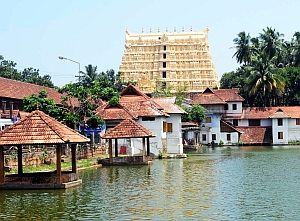Friday, April 19, 2024
News and Views from the Global South
INDIA: Temple Treasures Open Up Problems of Plenty
Ranjit Devraj
- The discovery that treasures lying in the vaults of an ancient temple in Thiruvananthapuram may be worth more than 25 billion dollars is raising questions regarding the vast wealth owned by religious shrines in this impoverished country.

The 18th century Padmanabhaswamy Temple in Kerala whose vaults hold more than 25 billion dollars worth of antique gold and jewels. Credit: Haris Kuttipuram/IPS
The temple, located in the capital of southern Kerala state, now ranks as the richest in the country, surpassing in wealth the popular Balaji Temple in Tirupati, Andhra Pradesh, which owns 3,000 kg of insured gold, apart from other assets.
One of the vaults of the Padmanabhaswamy temple, which could not be opened because of a complicated locking mechanism, is believed to contain the bulk of the treasures deposited there by the rulers of the former princely state of Travancore.
With the extent of the wealth now revealed reliably, a controversy has begun over its ownership.
Does it belong to the royal family that ruled the now defunct kingdom of Travancore or to the successor Kerala state? Or does it belong to a trust created by the former rulers when British colonial rule ended in 1947, giving way to the union of states that became the Indian republic?
Also, will the Archaeological Survey of India (ASI), which can claim treasure troves older than 100 years, have a say considering that two of the vaults were last opened 140 years ago?
Seema Alavi, professor of mediaeval history at the Delhi University, told IPS that one solution would be to house the best artifacts, which include gem encrusted crowns and jewellery and solid gold idols, in a museum.
“Kerala has a long history of maritime trade with the countries of the Middle East and with the West and the coin hoards are an indicator of the extent of the commerce,” said Alavi, referring to the 17th century Venetian ducats, Spanish pieces of eight and other numismatic rarities that tumbled out of the chests.
Alavi said the treasure was clearly a part of the heritage of the people of Kerala and of India.
“It would be practical that some part of the wealth is invested for the welfare of the people, but this is something for the Supreme Court to decide because there obviously are constitutional issues involved, ” said Alavi, author of ‘The Eighteenth Century in India’ and other academically acclaimed publications.
The matter was taken to the Supreme Court by the present head of the Travancore royal family, Uthradam Thirunal Marthanda Varma, after the Kerala High Court, acting on a petition, asked the state government to take control over the temple as the political successor to the royal family following independence.
Although India is constitutionally a secular country, the Indian state has through a series of legislations taken control over major Hindu temples, and handed over their administration to officialdom.
Control over temples exercised by various royal families ceased after 1971 when India legislated to ban hereditary titles and princely privileges including the right to a ‘privy purse’ as compensation for losing state revenues to the new Indian union.
However, many heads of royal families and their palaces still play a role in religious ceremonies, festivals and public processions conducted as part of continuing tradition.
Whatever the Supreme Court decides on the Padmanabhaswamy temple is bound to have a bearing on treasure troves that keep popping up in the thousands of Hindu temples scattered across the country that escaped wars and invasions.
In February, police investigating a case of theft at the 12th century Jagannath Temple in Puri, Orissa state, stumbled on a hoard of silver ingots weighing 18 tonnes. The ownership of the ingots is still disputed and some portion of the hoard appears to have been stolen.
Predictably, pro-Hindu groups have begun lobbying the government to secure the wealth found in such temples as Padmanabhaswamy on behalf of followers of that faith.
“Although it is clear that the wealth belongs to the (Padmanabhaswamy) temple and to the Hindus alone, there are certain vested interests with ulterior motives trying to create confusion among the public with their false and distorted claims on the temple wealth,” said a statement by Bharat Jagran, an international organisation that works to promote Hindu interests.
“The management of the temple should only be vested in a trust consisting of prominent Hindu spiritual leaders, head of the royal family, head priest and representatives of Padmanabha devotees,” the statement said.
Such demands can be problematic in Kerala state whose population of 32 million has large Christian (20 percent) and Muslim (25 percent) minorities.
Indeed, the present state government led by Chief Minister Oommen Chandy has fought shy of taking control over the temple and its assets, but has ordered police commando teams into the complex to protect the treasure.
Eminent jurist V.R. Krishna Iyer told IPS over telephone from Kerala that it was “in the public interest to hand over the treasure to a national trust and spend it for the welfare of the poor.”
Iyer, a former judge of the Supreme Court known for his progressive views, said there needed to be a secular approach since the treasure “is not wholly Hindu but has foreign elements, including donations of exotic diamonds, solid gold, large silver idols and other precious stones.”
Iyer said it would best for the treasure to be handed over to a “trusteeship that is beyond religion and beyond any particular denomination.”

 Print
Print



